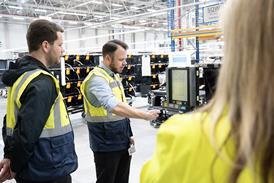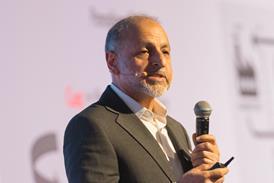Increasing local incomes are creating a top-end market in Brazil. Giovanna Riato takes a look at how the OEMs are responding
In the next few years, Brazil will go down the route of luxury car manufacturing. The local market has traditionally been focused on basic cars with engines up to 1.0 litres, but on the back of rising incomes there is growing demand for average models.

Sales of premium vehicles have also increased, the cheaper models of brands such as BMW, Audi, Mercedes-Benz, Land Rover, Volvo and Mini. In the first half of 2013, sales of imported vehicles in the premium segment increased by 36% to 4.2 billion reais ($1.9 billion). Given such figures, these companies have started to see the potential market in Brazil.
After months of studies and negotiations, BMW, Audi and Mercedes-Benz have announced investments in the construction of industrial complexes in Brazil. However, these plants will have to adapt to the requirements of Inovar-Auto, Brazil’s new automotive regime for low-volume production with a maximum capacity of up to 35,000 vehicles per year.
Within this category, companies need to meet targets for energy efficiency and investment in research, development and engineering, which can be undertaken by universities or independent institutions. The vehicle manufacturers also need to invest at least 17 billion reais in fixed assets per planned production plant.
While some companies are already set on the establishment of local manufacturing facilities, others are still conducting their research. For example, Jaguar Land Rover (JLR) has been considering the installation of a plant in Brazil since 2011. The project has been slowed by delays in the definition of the Inovar-Auto programme. A comprehensive survey detailing areas which could accept a plant, and the investment needed, was completed and sent to the company’s UK headquarters.
With this step completed, it is expected that JLR will announce an investment by the end of the year; the Ministry of Development, Industry and Foreign Trade will ensure that the company’s plans are viable. Meanwhile, government sources suggest that Volvo Cars is another OEM which is studying the potential manufacturing site.
BMW to build in Santa Catarina
The BMW project has been in development since 2011, but was announced only at the end of last year. The company will invest €200 million to build a plant in Santa Catarina, in the city of Araquari, which will have the capacity to produce 32,000 vehicles per year. The plant will have the capability to carry out all key manufacturing processes, including assembly, painting and welding. The first model out of the Brazilian lines will be the crossover X1, followed by the Series 1 and 3. BMW’s Santa Catarina facility is scheduled to open in 2014.
The project was presented by Ian Robertson, board member of BMW, to the president of Brazil, Dilma Rousseff. BMW estimates that the development will generate thousands of direct jobs. “We believe that the arrival of the first manufacturer of luxury vehicles is a milestone for the development of the automotive industry in the country,” stated Robertson.
BMW says the decision to invest in Brazil was made in light of the good prospects for the market in the long term. With the exception of 2012, when BMW sales in the area were impacted by higher taxes for imported vehicles, the company’s brand has grown in double-digits over recent years. With the establishment of a new plant in the region, the company will have the tools to support future development.
The car-maker has not confirmed its suppliers for the new operation, but for the launch of premium vehicle production in Brazil, BMW will need a specialised supply base. With some flexibility in the Inovar-Auto rules for manufacturers engaged in low-volume production, the company will import engines and transmissions with advanced technology.
Audi makes a comeback in São José dos Pinhais
 The changing economic context of Brazil has also attracted renewed attention from Audi. In September, the company announced the investment of €175 million to manufacture the sedan A3 and the compact SUV Q3 in one of the Volkswagen plants in the country, in São José dos Pinhais, Paraná. The company made the A3 at this location between 1999 and 2006.
The changing economic context of Brazil has also attracted renewed attention from Audi. In September, the company announced the investment of €175 million to manufacture the sedan A3 and the compact SUV Q3 in one of the Volkswagen plants in the country, in São José dos Pinhais, Paraná. The company made the A3 at this location between 1999 and 2006.
The project will require internal restructuring at the facility, which will have the capacity to produce 26,000 brand vehicles per year. The Audi models to be made locally will use the MQB modular strategy of Volkswagen. The same platform is used in the seventh-generation Golf, which will also be manufactured in Paraná. “Everything will be done under one roof that already exists. Volkswagen is a sister company of the same group; it is usual to share facilities around the world,” says Rupert Stadler, Audi’s global president, who visited Brazil to announce the investment.
The production of the A3 sedan will start in the second half of 2015, while the Q3 is scheduled for approximately one year later. “We planned a local content rate of 30-35%. For an international project involving several production units, that is an exceptionally high participation,” says Bernd Martens, vice-president of global purchasing organisation.
It is not yet decided if the stamped parts will be made in Brazil or be imported, but the local content ratio will easily be achieved by the 1.4 turbocharged flex engines, which will probably be produced in the Volkswagen plant in São Carlos, São Paulo. “We will reap the benefits of co-operation with the Volkswagen Group, that has been around here for 60 years,” says Martens. The vehicles will have other engine options which will be imported.
As the fourth largest vehicle market in the world, Brazil has thus entered Audi’s strategic plan for global growth, which by the end of this decade will supply 2 million units. This will be the second largest contribution to Volkswagen’s plan to become the largest vehicle manufacturer in the world by 2018. “Brazil is a very interesting market for us and I have emphasised that in recent months,” says Stadler. “We are confident in the country’s development,” he adds.
Martens notes that the decision to stop production in Brazil in the past was due to “no favourable economic conditions”. In his opinion, however, the situation has changed. The company estimates that by 2020 the premium vehicle segment will see growth of 170%. The existence of the Inovar-Auto scheme, which limited the import of vehicles through tax increases, also influenced the decision. “With the new policy, it would not be possible to compete in the market with no local production,” says Martens.
Mercedes-Benz invests in Iracemápolis
In early October this year, Mercedes-Benz revealed its plan to invest €170 million in facilities at Iracemápolis, Sao Paulo, for production of new-generation C-Class sedans and compact GLA SUVs. The capacity will be 20,000 vehicles per year, starting from late 2015 or early 2016
The manufacturing complex will cover 200,000 sq. m on 2.4 million sq. m of land. Despite the abundance of space, the company will not establish a supplier base on the same site. “We will use the great global suppliers that are already installed in Brazil, mainly German companies with whom we already have relationships in other countries,” explains Philipp Schiemer, CEO of Mercedes-Benz in Brazil.
The decision to build vehicles in Brazil is part of the company’s overall strategy to achieve leadership in the segment of luxury vehicles in 2020. In addition, local manufacturing will provide the brand with better conditions in which to compete in the Brazilian market with BMW and Audi, its main rivals. With its new manufacturing capabilities, Mercedes will also have the option in future to develop flexible engines which run on gasoline and ethanol to equip vehicles sold in the area.





























